Ten frames are becoming one of the most widely used models to teach a range of strategies in early maths. Ten frames are a good tool because they allow children to visualise quantities within the context of ten. Our number system is based around the number ten, for the simple reason that we have ten fingers. Our ancient ancestors used their fingers as one of the first tools of counting. Ten frames are a representation of this number system, and a great way for children to begin to think in pictures about numbers.
But how can you make ten frames, and what sort of simple activities can young children attempt on them?
Ten frames are great for play activities, and children enjoy simply exploring their features. They are particularly good outside, and I like to get children to find objects such as stones and sticks, and use them in different ways on the frame.
However, it is a good idea when introducing a ten frame to quickly demonstrate some of the more exciting games you can play on one. Ten frames take a little adult modelling to get children aware of their possibilities.
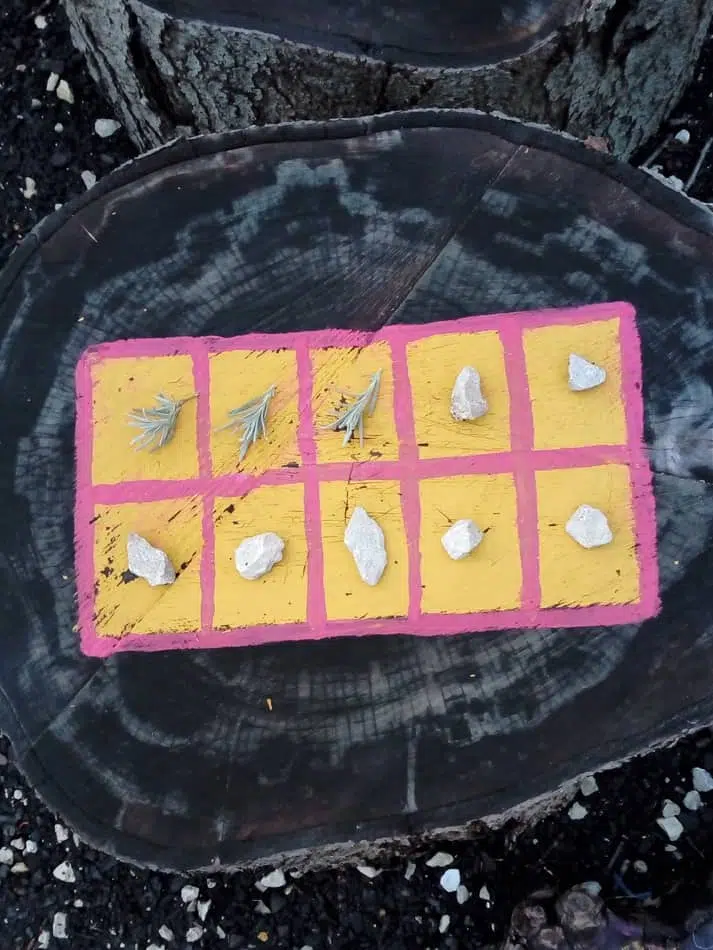
How can you make ten frames?
Ten frames can be made out of a range of materials, and can be used both inside or outside (the materials will depend on where you intend to use it). Here are some of my favourite ways to make a ten frame:
1. Popsicle sticks
This is quite a well known way of creating ten frames for play based activities.
Get some popsicle sticks and glue them into a 5 by 2 grid. You can then use different things to fill the frames – toy jewels is a nice one. Also items such as counters, blocks, minibeasts – anything small enough to fit in the gaps.
To find out the ultimate list of the greatest ever lolly stick activities, then check this out.
2. Egg boxes
I have found a yellow brand of egg boxes recently that have exactly ten sections.
Perfect for ten frames!
Many other boxes have twelve or fourteen sections for eggs, so you can just cut that part of the box off. These are great for putting many different things in – coloured pompoms work well.
You could, for example, find number bonds to ten by putting different numbers of green and red pompoms into the ten sections. You could also add coloured eggs or balls.
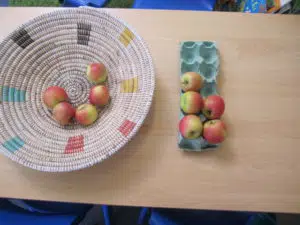
3. Paint lines onto tree stumps
I always use acrylic paint whenever I paint anything either inside or outside. It is very durable and can withstand many years of rain when applied to most surfaces.
Recently in my setting we chopped down a few trees and had a few stumps left in the ground. These were the perfect opportunity to paint some maths models and images onto, and a ten frame was an obvious choice.
I also like to paint ten frames onto logs that you can find or old planks. These become a great resource for filling with found materials such as stones, leaves, twigs and conkers.
This is a fantastic outdoor maths activity (check out 50 more outdoor maths ideas here)
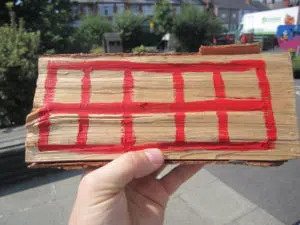
4. Chalk on the floor
Ten frames can very simply be drawn in chalk on the floor! Super quick and easy.
5. Use pieces of a sheet cut up
These are very appealing because of their texture and just their general look. These work better inside than outside, just because they get muddy and wet outside and you will probably have to end up washing them everyday.
These work well for indoor materials such as pretend bugs, maths equipment, jewels, coins etc
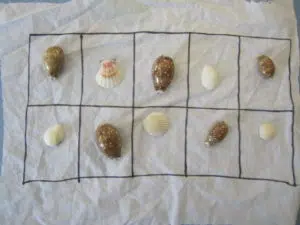
6. Use part of a trellis
If you have parts of an old trellis available to you, a section of it can very easily be used to create a very stylish and engaging ten frame. Once again, this really suits being filled with found objects -sticks, stones and the like.
7. Spray paint on the grass
Any type of paint will work, but it is better to use a water based paint so that it will wash away in the rain. Painted ten frames can be as big as you want, so
8. Ice cube tray with beads
This is a great fine motor activity. See if you can find an ice-cube tray with ten sections. Then drop different coloured beads into the compartments using tweezers.
9. Bury ten pots or tubs
This is a great activity for a sand area, or mud area. Simply dig 10 small holes in a ten frame array, and then put ten pots into the holes so that their lips are level with the surface. These are then great for dropping objects into.
10. Get the children to make their own
Ownership is one of the key features of engaged early years play, and getting children to create their own ten frames is a fantastic way of achieving heightened involvement in play activities using them.
A simple way of doing this would be to have ten frames on card, and the children decorate them by colouring or sticking on sequins. They could also decorate pre-made popsicle stick ten frames, or egg boxes. They could also choose what items to use in their ten frame.
Activities to play when you have made a ten frame:
1.Make a number
This is one of the best ways for young children to use a ten frame, and probably the best way to start.
Get them to make a number! Eg. 4.
There are so many different ways to make 4. Get, for example, four stones, and then experiment with a variety of formations. Children like comparing and copying their friends.
This activity helps them visualise what a number actually looks like in its many manifestations.
This is also excellent for one to one correspondence (check out the full guide on one to one correspondence here, with tips on the best ways to teach it).
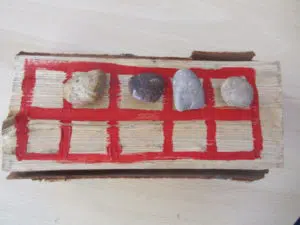
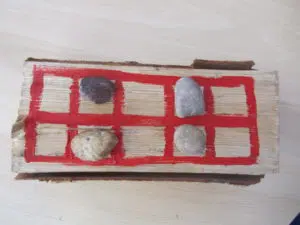
2. Make number bonds
If you fill a ten frame, you can’t help but make a number bond to ten. If you only use two types of object, this becomes even better because you then have pairs of numbers to make bond.
For example, you might have 6 sticks and 4 stones. The adult can provide the maths vocabulary into this simple exploration – ‘How many have you got altogether? You’ve got 6 add 4 more etc’.
3. Grab two numbers!
This is a good fun way of beginning to add on a ten frame. Have two types of objects in a pile, for example red jewels and blue jewels.
Take a handful of each and then place them on the ten frame. You might get three red and four blue. How many have you got altogether?
This is a great way to begin simple adding. It works best if you have an object that children can only pick up about two to five of so that they don’t overfill the frame.
4. Make patterns
Ten frames are a great way to create patterns. The simplest is a 1:1 pattern, for example one pine cone, one conker, one pine cone, one conker… There are other ways to make patterns on ten frames.
You can make easily make a 2:2 pattern by putting the same item above the other.
To find out the best 21 pattern activities for kids, then take a look at this.
5. Doubling
Doubling is a very visual skill, and ten frames are perfect for achieving it.
Simply, whatever you put in one line of the ten frame, put exactly the same in the bottom line. You then have two of whatever you originally had.
Again, the adult can provide the maths vocabulary, such as ‘double’, ‘two lots of’, and ‘altogether.’
6. Symmetry
Two ten frames placed next to each create a host of additional learning opportunities. My favourite of these is symmetry.
Whatever you put on one frame, copy it ‘mirror-fashion’ on the other. This can be quite hard for children to grasp, and it is a good idea to place something in the middle of the two frames, like a line or a stick.
Then show them how to walk your fingers outwards from the middle line, and whatever you find on one side copy on the other.
A simpler way to do this is to put a mirror next to a ten frame you have made. Children can explore what the reflection of the ten frame looks like.
To find out the ultimate list of ten hands-on symmetry activities then go here.
7. Match numeral to quantity
For this you will need some number cards, number stones, or some materials for children to write their own numbers. Get them to put an amount in the frame, and then place the correct number next to the frame.
An excellent number recognition game.
8. Make a picture!
This is a very simple activity for even very young children. Simply arrange different objects in and around the frame to try and make an image. Good examples might be a house with lots of windows, or an alien with lots of eyes. However, see what the children come up with!
9. Ten frames flash!
This is a more adult-led activity. Have a selection of ten frame images and show the children very quickly. They try to guess the number, but the idea is that in the end they don’t need to count the number of things on the frame. The idea is to ‘see’ it, and start to understand that if the ten frame is full it is ten, if it is half-full it is five, if it is full apart from one square it is nine and so on.
10. Leaves v stones!
This is a race and a competition, which are both great for children in general, and certainly good for maths. This works well on an outdoor ten frame like a painted log.
Two children go head to head. One child is going to find one thing, for example stones, the other is going to find something else, for example leaves. They can only find one at a time, put it on the ten frame and then go and find the next. The race is over when the ten frame is full, and then they count up to see who has got more objects on the frame.
Incidentally, whatever they come up with is also always a number bond of ten.
READ MORE
